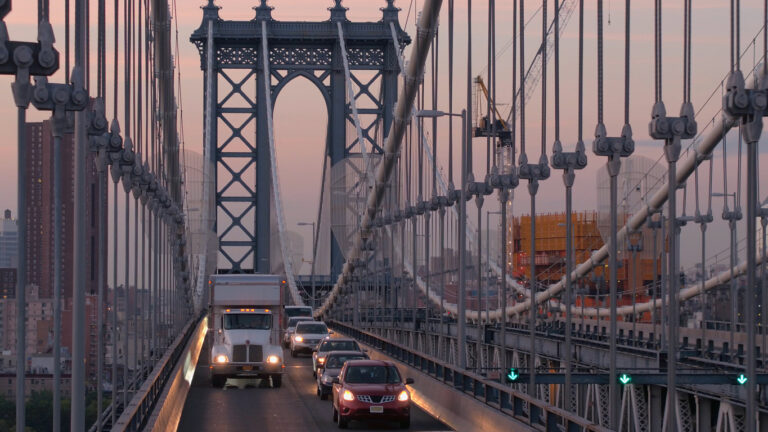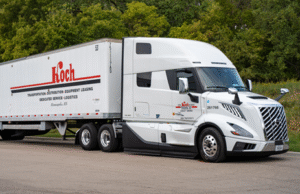The Trucking Association of New York (TANY) along with industry stakeholders and sustainability advocates, Tommy Kharieh of Walton Hauling, Russel Pedrick of Lucky’s Trailer Sales with Dimmick Group Peterbilt, and Rocco Lacertosa of New York State Energy Coalition, are highlighting the industry’s commitment to utilize a number of “bridge solutions” which will help reduce emissions in New York State amidst a delay of the Advanced Clean Truck Act (ACT) rule.
During a recent webinar, the group spoke about how alternative solutions have a substantial positive impact on the environment and can pave the way for a greener, cleaner New York.
“These bridge solutions, which we will highlight today, give us an opportunity to reduce emissions while the electric infrastructure is being established and the trucking market matures to support the next generation of vehicles,” said Kenda Hems, TANY president. “Today I am joined by several colleagues to discuss these meaningful sustainability initiatives that will allow our industry to continue its decades long effort to reduce emissions while meeting America’s growing freight needs. Before we hear their perspective, I do want to address the ill-informed and outdated accusations that have been cast on our industry as we appeal for a delay of the advanced clean trucks rule, the ACT. Many have been quick to bash our industry without noting all the tremendous strides we have made to deliver on a cleaner tomorrow.”
Hems noted that trucking has “virtually phased out harmful sulfur and diesel fuel, practically eliminated sulfur oxide emissions and significantly reduced fine particular, particular matter from trucks improving the air quality, wellbeing and livability of our communities.”
Making Strides in the Industry
“Walton Hauling is proud to have led the way on adopting renewable clean diesel technology in our truck fleet,” Kharieh said. “But we still have strides to make. Unfortunately, given the high costs associated with electric trucks, the charging infrastructure and the operational capabilities, the short range of electric truck does not allow us to be able to complete a days’ worth of work, we are not in the position to transition to electric trucks. For our needs, and for other operators of our size, we have to turn to alternative fuel sources to keep our communities clean while improving our fleet sustainability.”
According to TANY, the trucking industry remains committed to making strides towards a more sustainable future, including through existing electrification efforts.
“What is often left behind in the conversation surrounding electrification is that it is not the only path towards a lower-emission future,” TANY said. “In a state like New York, where nearly 90% of all communities in New York depend exclusively on trucks to move their goods, we must get emissions legislation right. If we don’t, communities across the state run the risk of seeing increased costs, and New York businesses face the prospect of tightening business pressures.”
Lack of Infrastructure
“Forcing the industry to transition to electric when the infrastructure simply doesn’t exist is a destructive approach that fails to consider the historic and continued investments we have made to reduce emissions,” TANY said. “Since 1974, the trucking industry has reduced its rates of pollution by 99%. At the core of this work has been a transition to clean diesel. Yet, clean diesel is not the only alternative fuel available.”
Helpful for Last-Mile Deliveries
While electrification has provided benefits for last-mile deliveries, it is currently unsustainable for long-haul trucking, given the reality that New York has no publicly available medium- or heavy-duty chargers. Instead, TANY members are exploring options such as hydrogen-electric fuel cell trucks or renewable diesel to serve long-hauling needs, given that hydro-cell trucks have longer ranges and shorter refuel times compared to their electric counterparts.
“What has become clear during the current debate surrounding the Advanced Clean Trucks Rule is that, given the diverse nature of shipping and logistics in New York, there is no one-size-fits-all approach to deliver goods,” TANY said. “There is and should be room for renewable clean diesel, hydrogen-electric, and electric trucks amongst other alternative fuels to service the needs of New Yorkers.”
Lost Jobs, Shuttered Businesses
“We have repeatedly mentioned the financial implications the Advanced Clean Truck Act is already having on the industry: lost jobs, closed businesses, and increased costs,” Hems said. “What we have yet to talk about, is how our current sustainability initiatives are being impacted by this regulatory framework. 60 trucks on the road today equals the output of one truck in 1988 – CARB Standard Certified Clean Idle Trucks, as well as alternative fuels and technologies such as renewable diesel, CNG, hydrogen, hybrid, and telematics are all prominent throughout the industry, and they are essential tools to continue this progress on an achievable timeline. One solution is not the answer, they all are.”
Sales Derailed
“Dimmick Group Peterbilt just recently was put in the position where we could not complete the sale of an electric truck,” Pedrick said. “Our customers, whether they are in NY or beyond, are looking for alternative solutions to sustainable trucking and electrification represents only one possible avenue towards a cleaner future. As such, PACCAR has been investing in renewable hydrogen technologies to service the needs of our ever-changing industry.”
Biofuels – Immediate Impact on Industry
“Biofuels are a right-now cleaner energy solution that can make an immediate impact on transportation emissions without costly retrofits as the buildout of electric infrastructure slowly moves along,” Lacertosa said. “Our industry has long driven the innovation of cleaner fuels, and we are seeing more fleet operators — from private haulers to municipalities like New York City — turn to these options as their performance and emissions benefits improve. We are proud to work closely with TANY and their members to prioritize progress and keep New York’s economy trucking along.”
Burdening the Middle Class
“Now is not the time for New York State to add yet another burden to working in middle class families,” Hems said. “The implementation of these regulations will only hinder our continued economic recovery leading to unnecessary increased costs for New Yorkers and air repairable harm to our industry. Again, we are not inherently against increased sustainability measures. We all want cleaner air, less traffic and more efficient trucks, yet a CT at this time will not deliver the results the state intended when first adopted. Recently, both Maryland and Massachusetts have recognized the challenges and burdens they are causing with a CT and have adopted to delay implementation in their states to allow more time for technology and infrastructure to catch up. And we are hopeful that New York will do the same. It is important to note that delay of a CT doesn’t mean that we can’t still achieve emissions reductions in the industry. There are so many exciting new technologies and programs we can invest in that offer the promise of further reductions. These are practical solutions with lasting impact on the environment and our communities.”













